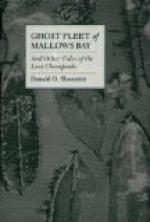And in the depths the pungy
sank;
And, as the divers
told,
They sought the wreck to lift
again,
And found the
pirates’ gold.
And in a chapel close at hand
The pious freedmen
toil;
No slaves are left in all
the land,
Nor any pirates’
spoil.
TICKING STONE.
People say that a certain tombstone in the London Tract “Hardshell” Baptist graveyard, near Newark, Delaware, will give to the ear placed flat upon it the sound of a ticking like a watch. The London Tract Church, as its name implies, was the worshipping place of certain settlers who either came from London, or chose land owned by a London company. It is a quaint edifice of hard stone, with low-bent bevelled roof, and surrounded by a stone wall, which has a shingle coping. The wall incloses many gravestones, their inscriptions showing that very many of the old worshippers of the church were Welsh. Some large and healthy forest trees partly shade the graveyard and the grassy and sandy cross-roads where it stands, near the brink of the pretty White Clay Creek.
I climbed over the coping of the graveyard wall last spring, and followed my companion, the narrator of the following story, to what appeared to be the very oldest portion of the inclosure. The tombstones were in some cases quite illegible as to inscriptions, worn bare and smooth by more than a century’s rains and chipping frosts, and others were sunken deep in the grass so as to afford only partial recompense for the epitaph hunter.
“This is the Ticking Stone,” said my companion, pointing to a recumbent slab, worn smooth and scarcely showing a trace of former lettering; “put your ear upon it while I pull away the weeds, and then note if you hear any thing.”
I laid my ear upon the mossy stone, and almost immediately felt an audible, almost tangible ticking, like that of a lady’s watch.
“You are scratching the stone, Pusey,” I cried to my informant.
“No! Upon my honor! That is not the sound of a scratch that you hear. It cannot be any insect nor any process of moving life in the stone or beneath it. Can you liken it to any thing but the equal motion of a rather feeble timepiece?”
I listened again, and this time longer, and a sort of superstition grew over me, so that had I been alone, probably I would have experienced a sense of timid loneliness. To stand amidst those silent memorial stones of the early times and hear a watch beat beneath one of them as perfectly as you can feel it in your vest pocket, and then to feel your heart start nervously at the recognition of this disassociated sound, is not satisfying, even when in human company.
“This is the best ghost I have ever found,” I said. “Perhaps some one has slipped a watch underneath, for it is somebody’s watch; there is something real in it.”
“I took the stone up once myself,” said Pusey, “and the ticking then seemed to come up from the ground. While I deliberated, an old man came out of yonder old sexton-looking house, and warned me not to disturb the dead. He crossed the wall, and assisted me to replace the stone, and then bade me sit down upon it, ancient mariner-like, while he disclosed the cause of the phenomenon.”




